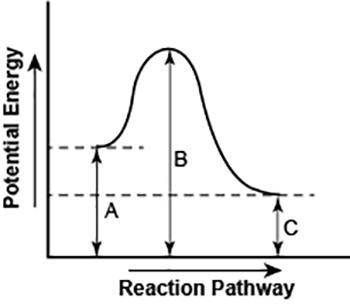
Chemistry, 21.04.2021 06:20 brunovillarreal6576
Part 1: Looking at the diagram above, what can you tell me about the type of reaction it is? Is this exothermic or endothermic? How do you know? Make sure you support your answer by using the diagram.
Part 2: Thinking about enthalpy and a change in enthalpy, explain how you could find the total change of enthalpy based on this diagram. Is the enthalpy positive or negative?
Part 3: How could you find the activation energy? Is the activation energy positive or negative?


Answers: 3


Another question on Chemistry

Chemistry, 22.06.2019 08:00
Why is the bond angle in a water molecule less than the bond angle of methane? a. the central oxygen atom in water has two lone pairs of electrons, whereas the central carbon atom in methane has no lone pairs. b. the central hydrogen atom in water has one lone pair of electrons, whereas the central carbon atom in methane has two lone pairs. c. the central oxygen atom in water has four lone pairs of electrons, whereas the central carbon atom in methane has only one lone pair. d. the central oxygen atom exerts more repulsive force on surrounding atoms than the central carbon atom in methane does. reset next
Answers: 2

Chemistry, 22.06.2019 08:00
Will give ! what are the advantages and disadvantages of nuclear power? check all that apply. one advantage of nuclear energy is that it does not produce carbon dioxide emissions. storage of nuclear waste is a short-term problem associated with nuclear energy. the problem with uranium mining is that a large quantity of uranium must be extracted to meet energy needs because the energy release from uranium fission is so low. safe operation of a nuclear power plant can be jeopardized by a human mistake.
Answers: 1

Chemistry, 22.06.2019 09:00
Which explanation is true about what happens to a ray of light when it strikes a mirror? a. a light ray is transmitted toward a mirror at a certain angle. the light ray is then reflected by the mirror at an equal angle but in the opposite direction of the transmitted ray. b. an incident ray strikes a mirror at an angle with a line perpendicular to the mirror. the light ray is then reflected at an angle equal to the angle of incidence but on the opposite side of the perpendicular line. c. a reflecting ray strikes a mirror at an angle with a line perpendicular to the mirror. the light ray is then refracted at an angle equal to the angle of the reflecting ray and on the same side of the perpendicular line. d. an incident ray strikes a mirror at an angle with a line parallel to the mirror. the light ray is then transmitted at an angle equal to the angle of incidence but on the opposite side of the parallel line. you so much! : -d take the time to try and answer correctly.
Answers: 3

Chemistry, 22.06.2019 17:00
Reduction is a reaction which results in a in electrons and a in positive charge of the atom or ion 1) a- loss 1) b- gain 2) a-increase 2) b-decrease
Answers: 1
You know the right answer?
Part 1: Looking at the diagram above, what can you tell me about the type of reaction it is? Is this...
Questions

Mathematics, 04.10.2020 08:01



History, 04.10.2020 08:01


Mathematics, 04.10.2020 08:01

Mathematics, 04.10.2020 08:01


Mathematics, 04.10.2020 08:01




Chemistry, 04.10.2020 08:01

Mathematics, 04.10.2020 08:01

Mathematics, 04.10.2020 08:01

Physics, 04.10.2020 08:01

Mathematics, 04.10.2020 08:01

English, 04.10.2020 08:01

Computers and Technology, 04.10.2020 08:01



